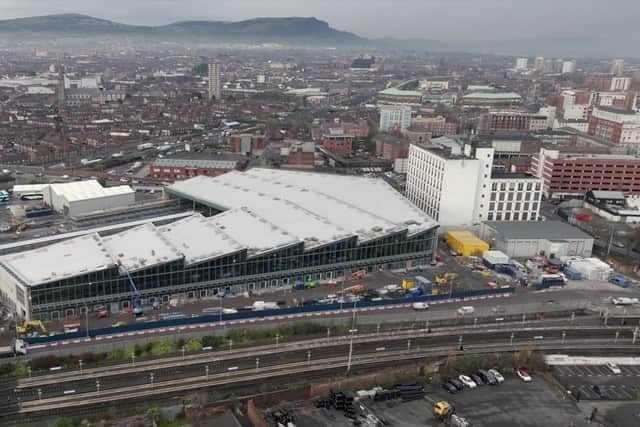Belfast City Council gives green light to Irish language signs at new Grand Central Station and Weaver's Cross development


At a recent committee meeting in City Hall, elected representatives approved a Sinn Féin motion supporting dual language Irish signage at the new transport development. The motion also calls for Irish signage in the wider Weaver’s Cross area, which is still in the early stages of planning and development.
At the council’s Standards and Business Committee twelve members voted for the proposal and five against.
Advertisement
Hide AdAdvertisement
Hide AdThe proposal by Councillor Róis-Máire Donnelly states: “Belfast City Council acknowledges the significant progress made in promoting the Irish language within our jurisdiction, including the formulation of a Language Strategy in 2018, the revision of the dual language street signage policy in 2022, and the formulation of a draft Irish language policy in 2024.
“To further this commitment, the council fully supports the installation of bilingual internal and external signage at Cros na bhFíodóirí – Weavers Cross – Belfast’s new Grand Central Station.
“As a result, this council will also write to Translink urging them to install bilingual signage at Weavers Cross and to ask what steps they are taking to fulfil their obligations under the European Charter for Regional and Minority Languages, and ensuring shared public spaces are welcoming and cater to the bespoke needs of the Irish language community.”
The committee decision will go to this month’s full Belfast City Council meeting on April 8th for ratification, but is likely to be confirmed due to the majority numbers in favour at committee level.
Advertisement
Hide AdAdvertisement
Hide AdThe new world-class integrated transport hub, set on an extended site beyond the old Great Victoria Street bus and train station, is rapidly progressing through the last stages of final construction. It is due to be completed towards the end of 2024, with full project completion, including all public realm upgrades, expected in the third quarter of 2025.
In 2022 Belfast City Council’s Planning Committee unanimously approved “outline” permission for the Weaver’s Cross regeneration development plan, on lands freed up by the future closure of the existing Europa Bus Station and Great Victoria Street train station.
A mixed-use development will be located to the east and west of Durham Street, south of Grosvenor Road, stretching as far as Sandy Row, and involves new office space, residential apartments and a hotel. It is also planned to provide new public realm space, active travel, hospitality and community uses.
Around a fifth of this space has been proposed for housing, with a fifth of the residential space set aside for social/affordable housing. This means that half of this final allotted space will be “social”, the other half “affordable.”
Advertisement
Hide AdAdvertisement
Hide AdThe council received 14 letters of support and 143 letters of objection to the Weaver’s Cross development, including an objection from the County Grand Orange Lodge of Belfast.
The majority of the objections related to the removal of the Boyne Bridge and introduction of new pedestrian crosses associated with the Belfast Grand Central Station plan.
Last October the council, without unionist support, agreed a bulk plan for bilingual street signs in west Belfast’s Gaeltacht Quarter. The area has 417 streets, 108 of which already have Irish signage.
Sinn Féin originally proposed the motion, highlighting the potential for City Hall to save hundreds of thousands on a bulk designation, rather than individually surveying streets in which an overwhelming majority would be in favour of Irish signs.
Advertisement
Hide AdAdvertisement
Hide AdThe estimated cost of signage for the streets currently identified within the Gaeltacht Quarter is in the region of £135,000, with an extra £9,652 to be spent on the mail drop and advertising.
Sinn Féin state the cost of going through each Gaeltacht application individually would be £359,370, meaning the en bloc approach would save the council £209,718.
In 2022 Belfast councillors agreed a new policy on dual language street signs. Sinn Féin, Alliance, the SDLP, the Green Party, and the People Before Profit Party all support the new street sign policy, while the three unionist parties, the DUP, UUP and PUP, are against it.
The new policy means at least one resident of any Belfast street, or a councillor, is all that is required to trigger a consultation on a second nameplate, with 15 percent in favour being sufficient to erect the sign. Non-responses will no longer be counted as “against” votes, and there will be an equality assessment for each application.
Advertisement
Hide AdAdvertisement
Hide AdBefore that the policy required 33.3 percent of the eligible electorate in any Belfast street to sign a petition to begin the process, and 66.6 percent to agree to the new dual language sign on the street.
There are around 700 streets across the whole of the city with outstanding applications for dual-language street signs.